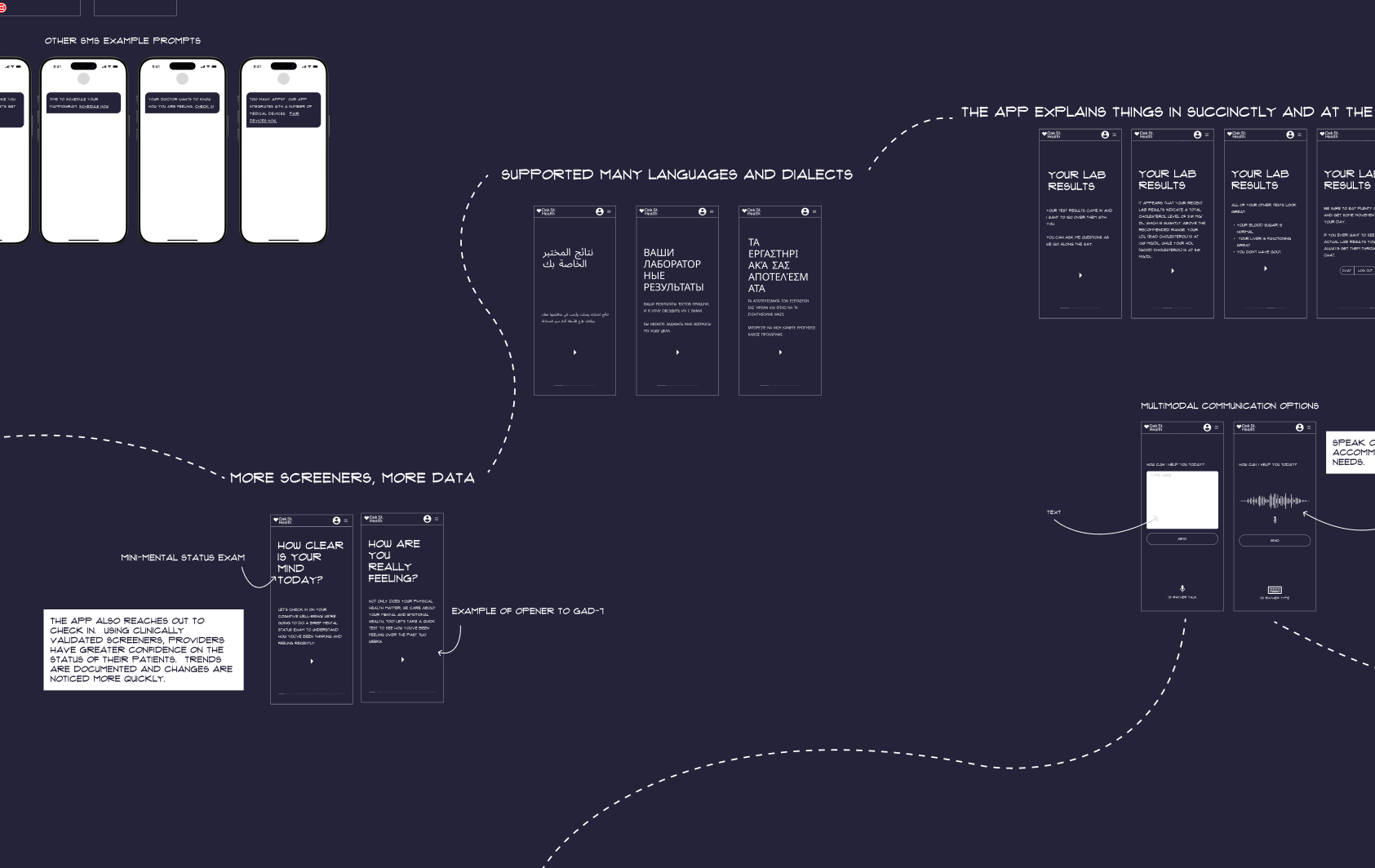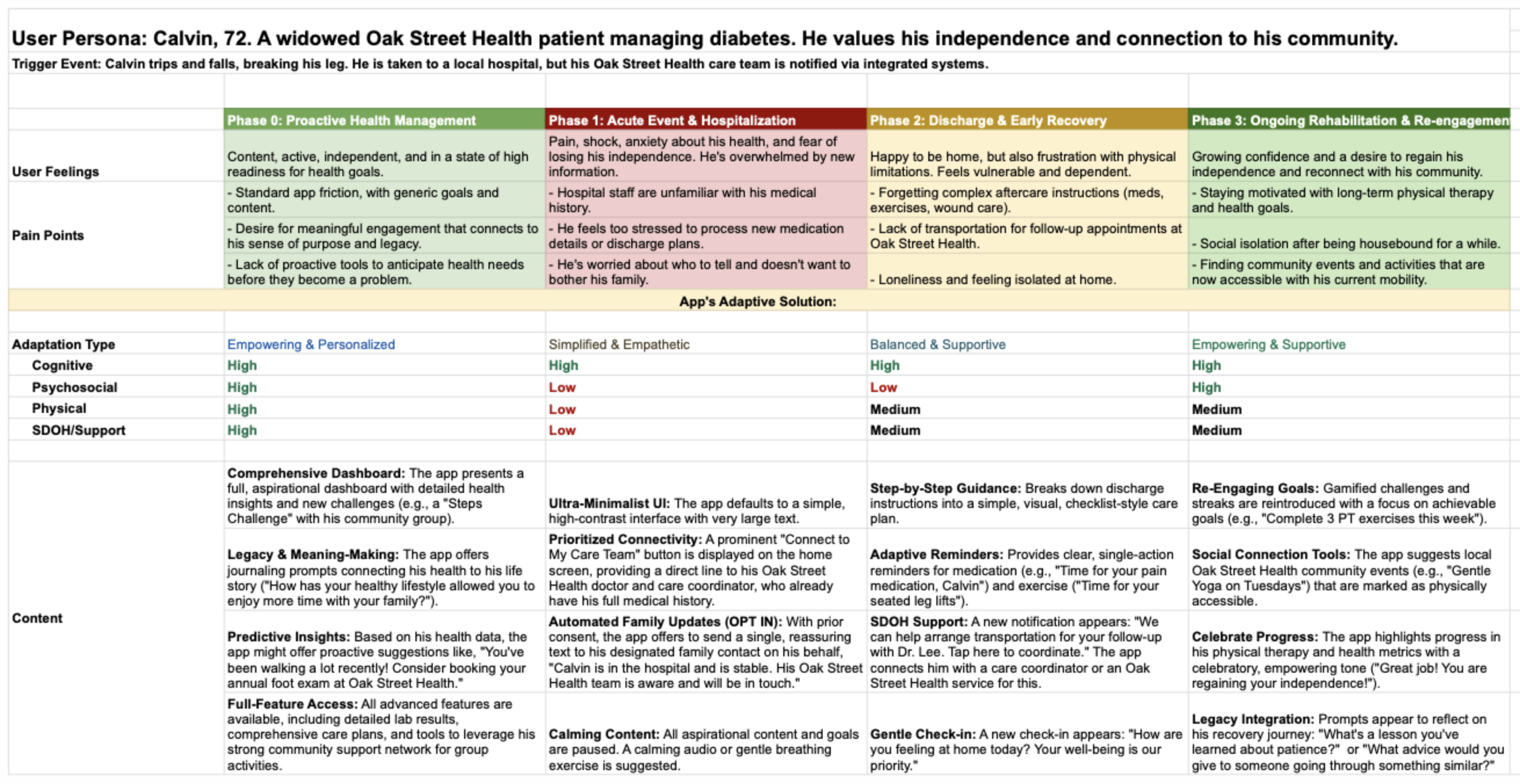Developmentally adaptive UX for the CVS Superapp
CVS Health serves an incredibly diverse population, each navigating a unique health journey. From a teenager facing a new diagnosis to an elder managing chronic conditions, and the caregivers supporting them, their needs, emotional states, and digital literacy are distinct. How could I ensure our digital health experience truly resonates with everyone, providing personalized, empathetic support at scale?
OVERVIEW
I led the initial conceptualization and strategic design for the Developmentally Adaptive UX, a groundbreaking initiative aimed at transforming the CVS SuperApp into an intelligent, responsive platform. This project was a strategic discovery effort, not for immediate build, but to define a new paradigm for digital health that dynamically adjusts its interface, tone, and features to meet individual user needs across their lifespan and health journey.
WHAT I DID
AI-powered conceptual development, secondary research (gerontology, developmental psychology, cognitive load theory), persona definition, strategic framework creation (adaptive matrix), adaptive prototyping (concept screens), heuristic analysis.
MY ROLE
Senior User Experience Designer / Strategist
Step 1: Defining the problem
It was during this phase that I realized that a one-size fits all approach would not work for users.
My research revealed a critical gap: our existing digital health platforms, while robust, operated on a largely one-size-fines-all model. This created significant friction for our most vulnerable users, as exemplified in the personas listed here:
For Calvin (the elder): A standard app with small text and complex navigation led to frustration and disengagement, undermining his dignity and sense of control.
For Nina (the burned-out caregiver): Overloaded dashboards and constant notifications amplified her stress, rather than alleviating her burden.
For Jay (the teenager): A clinical, impersonal interface failed to engage him, risking adherence to his treatment plan.
For Luis (the patient with cancer): A chaotic interface exacerbated his feelings of being out of control during a critical life period.
I understood that while the core goal of "health management" was constant, the path to achieving it was highly individual. A static experience, even a well-designed one, was inadvertently alienating significant portions of our user base, impacting health outcomes and customer loyalty.
STEP 2: exploring the opportunity
To solve this, I recognized the need for a developmentally adaptive UX. My research into human development, cognitive load, gerontology (like Sheldon Tobin's Preservation of Self), and the psychology of chronic illness confirmed that an effective digital health solution must be fluid, not fixed.
What is an Adaptive UX in this case?
It's a system where the app's interface, content, and interactions dynamically change based on real-time and historical data reflecting a user's unique cognitive ability, psychosocial bandwidth, physical capacity, and social determinants of health (SDOH). Unlike simple personalization, adaptation profoundly alters the core experience.
Why is this a powerful solution for CVS?
Unmatched Personalization: It allows us to speak directly to the individual, fostering a deep sense of understanding and trust that static apps cannot. This builds genuine customer loyalty.
Improved Health Outcomes: By reducing friction and cognitive burden, we increase engagement and adherence to care plans, directly impacting patient well-being.
Strategic Differentiation: In a crowded digital health market, this adaptive approach, driven by AI, positions CVS as a pioneer, offering a superior, empathetic experience that sets us apart.
Operational Efficiency: By anticipating needs and simplifying tasks, we reduce calls to care teams and streamline administrative processes.
STEP 3: WHAT ARE our GOALS?
My primary focus was on outlining how this approach would enhance user engagement, improve health outcomes, and drive cross-service adoption within the CVS SuperApp ecosystem.
STEP 4: From Concept to Adaptive Prototype
My approach was a strategic exploration, leveraging AI as a conceptual partner:
AI-Assisted Persona Definition: I began by refining our core user archetypes. Using an AI tool (Gemini), I provided detailed descriptions of Calvin, Nina, Jay, and Luis, outlining their specific challenges, needs, and emotional states. Gemini helped me to deconstruct these narratives into granular, actionable insights relevant to a digital health experience, identifying implicit pain points and translating qualitative statements into explicit design requirements.
2. Building the Adaptive Matrix (AI-Driven Framework): This was the core strategic output. I prompted Gemini to map these unpacked persona needs directly to the four adaptive dimensions I had established: Cognitive Load, Psychosocial Bandwidth, Physical Capacity, and Social Determinants of Health (SDOH). Gemini facilitated the systematic categorization, clarifying how each persona's unique needs translated into specific adaptive responses within the app's environment. For instance, for Calvin's "dislike for apps," Gemini highlighted how this translated to adaptations in "Cognitive Load" (simplified interfaces) and "Physical Capacity" (larger touch targets).
3. AI-Powered Ideation for UI/UX Adaptations: With the personas mapped to the adaptive dimensions, I challenged Gemini to brainstorm concrete, actionable UI/UX recommendations for each intersection within this matrix. Gemini did a fairly good job with ideation and translation, providing specific examples like dynamic font resizing, context-aware voice-activated interfaces, proactive resource linking, and adaptive tone shifts in messaging.
I was able to use Gemini to demonstrate the app’s capabilities over time and changing needs.
4. Conceptual Prototyping (Illustrative Screens): This project was about strategy and vision, not a final build. Based on the matrix, I designed a series of conceptual screens. These weren't fully interactive, but served as powerful visual prototypes to illustrate the adaptive concept. For example, I designed a set of screens for a caregiver's dashboard that would drastically simplify when the AI detected signs of burnout, or a patient's homepage that would transform into a voice-first interface for someone with severe dexterity issues. The goal was to tangibly demonstrate how the app would dynamically change, bringing the adaptive vision to life for stakeholders.
Step 5: METRICS AND SCOPE
While not for immediate implementation, I defined a forward-looking set of metrics to quantify the strategic success of this approach once built. These included:
Enhanced User Engagement: Projected increases in Daily/Weekly Active Users, session duration, and feature adoption rates (e.g., medication adherence, appointment scheduling).
Improved Customer Satisfaction: Anticipated gains in NPS (Net Promoter Score) and positive qualitative feedback driven by a personalized experience.
Operational Efficiency: Predicted reduction in support calls and increased self-service rates across CVS services.
The scope of this discovery project was to define the "what" and "why" of the adaptive UX, proving its strategic value and feasibility through AI-powered conceptual development and illustrative design.
Final approach and strategic impact
This strategic case study and its conceptual prototypes were presented to executive leadership as part of a larger vision for the CVS SuperApp. The project received enthusiastic approval, validating the vision for an AI-powered, developmentally adaptive UX as a core pillar of CVS Health's future digital strategy.

